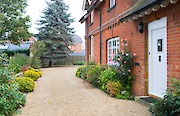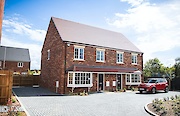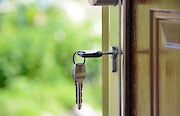


Content Writer

Mortgage Advisor & Director

Purchasing an adjoining property can be a useful way to acquire more living space without needing to move or upsize, but it comes with some unique challenges. Here, we’ll cover what you need to know about buying the house next door (whether combining or dividing dwellings), including how to get a mortgage and available lenders.
Can you buy two houses next to each other?
Yes, you can buy the house next door if the owner is willing to sell it. In some ways, it’s treated just like buying any other residential property as a second home. The purchase process will involve the usual steps: agreeing on a price with the seller, arranging a mortgage or financing, instructing solicitors, and completing the sale.
However, the process can differ depending on what you plan to do with the house after the purchase:
-
Two dwellings: If you intend on dividing the house into two dwellings, keeping both properties separate, you can usually get a standard mortgage on each one.
-
Combined property: If your goal is to combine the two into a single dwelling (for example, knocking through to create a larger home), you’ll need to consider planning permissions, building regulations, and possible mortgage restrictions.
Some lenders may only allow you to combine the properties if the title deeds are merged, while others could offer restricted mortgage options due to the potentially more difficult resale of a combined property.
How to get a mortgage to buy the house next door
Your ability to successfully secure a mortgage will depend on your goals for the properties and whether you’re simply looking to buy the house next door or plan on making changes to the current structures.
Buying the house next door as a separate dwelling
If you’re simply purchasing the adjoining house as an investment or perhaps for family use, you can usually arrange a second home or buy-to-let (BTL) mortgage. However, there are several lenders that will decline mortgage applications for adjoining properties.
Lenders will assess your application based on your affordability, deposit size, existing debt commitments, potential rental income (for BTL), and other factors. You’ll also need to pay additional Stamp Duty Land Tax (SDLT), or the regional equivalent, if you already own a primary residence.
Here are key points to keep in mind about using a mortgage to buy the house next door:
-
Deposit: Typically 5% to 10% minimum (so a 95% or 90% LTV), but can be higher for BTL, depending on the lender, type of mortgage, and property.
-
Loan-to-value (LTV): Certain lenders will have maximum LTV ratios for second homes and BTL properties, which could mean a larger deposit.
-
Stamp duty: Higher rates usually apply for second homes; typically, you’ll need to pay an extra 3% on top of SDLT (Land and Buildings Transaction Tax in Scotland or Land Transaction Tax in Wales).
-
Council tax: Each dwelling remains assessed separately, meaning two individual council tax payments.
-
Insurance: You’ll need home insurance policies for each property, and possibly a larger life insurance insured sum.
-
Existing property: Your existing home will likely be factored into the overall LTV calculations, and your current repayments will play a role in your affordability assessment.
Buying and dividing into two dwellings (or merging into one)
If your goal is to knock through and merge both houses into one or split them into multiple dwellings, the mortgage process is more complex. Some lenders treat this as a form of development finance or self-build, which may require a specialist mortgage.
-
Merging two into one: You may need a specialist lender willing to lend on non-standard construction properties, and the council tax band may be reassessed (knocking two houses into one could eventually result in just one council tax bill).
-
Dividing into two dwellings: You’ll likely need planning permission and separate titles, and lenders will usually want assurance that the properties can be resold individually. Sometimes, bridging finance or development finance is used before switching to standard residential mortgages once work is complete.

Begin your mortgage journey
What lenders are available?
The exact number of lenders available will depend on what type of mortgage you’re getting. For example, not all lenders will offer second home mortgages, and others may not offer buy-to-let mortgages. Your application, type of adjoining property, and personal circumstances will narrow down your pool of available lenders.
Your situation and intended use of the second property after the purchase will determine your borrowing options, but here are a few examples of popular UK mortgage lenders who may be open to letting you borrow to buy the house next door:
-
NatWest: If you get a mortgage with NatWest to buy the house next door, they will factor in your existing mortgage repayments and other property-related costs in the affordability calculations. You’ll need at least a 10% deposit (meaning a 90% LTV). If it’s a buy-to-let second mortgage, the minimum deposit is 25%-35%.
-
Lloyds Bank: You’ll need at least a 25% deposit (meaning a 75% maximum LTV) to buy the property next door as a second home with Lloyds Bank. If it’s a second home to let, the adjoining property must be worth at least £50,000.
-
Halifax: There’s a maximum LTV of 75% with Halifax for a second property (meaning at least a 25% deposit for a residential or BTL mortgage), and you can’t own more than one other residential property. Renovation properties are considered on a case-by-case basis if you’re planning on knocking the two houses into one.
The best way to carry out the most accurate comparison of lenders and rates is with the guidance of a specialist broker. However, you can use our free comparison tool below to compare current interest rates from 90+ UK lenders to get an idea about how much your payments could be for a mortgage when buying the house next door:
Compare Rates
Showing Top Result Results
No results matching your criteria
Lender Details
Product Details
Are there other considerations?
When buying the house next door, whether dividing the house into two dwellings or knocking the two houses into one, it’s important to think beyond the mortgage:
-
Legal process: You’ll need a solicitor experienced in title merging or splitting. Party wall agreements may also apply if you’re knocking through.
-
Restrictive covenants: Some properties may have clauses preventing structural alterations or multiple dwellings.
-
Resale value: A single large property (especially if non-standard construction) may be harder to resell than two standard homes. Always weigh up long-term marketability, especially if the property comes with mortgage restrictions.
-
Taxes: You need to consider any additional SDLT (or local equivalent) for second homes, potential Capital Gains Tax (CGT) on a potential future sale, and council tax reassessment if you merge the properties.
-
Access and services: Utility connections, rights of way, and service lines may need updating when merging or splitting properties. This often requires some more expert support or guidance.
Why choose Teito when buying the house next door?
Buying an adjoining property or combining two homes will work differently from a standard home purchase, which is why working with a specialist mortgage broker is the best way to get the result you want.
Whatever your home ownership goals with the house next door, our brokers have plenty of experience arranging tailored mortgage solutions for complex property purchases.
Here are some more reasons why homebuyers across the UK trust us to help them when buying the house next door:
-
Compare current mortgage rates online for free
-
Our brokers are 5-star rated on leading review sites
-
Free initial chat, with no obligation to proceed further
-
Access to niche lenders who understand adjoining dwellings
If you’d like to compare the latest deals or speak with an experienced advisor about purchasing the house next door, you can get started here.
FAQs
In most cases, you’ll need separate mortgages for each property unless you merge them into a single title, which involves a more complex legal process. Certain specialist lenders may consider one loan secured against both properties.
Choosing an Adviser
Selecting a qualified and experienced mortgage adviser is of great importance. To choose a suitable adviser, evaluate their qualifications, experience, and reputation, and ensure they are regulated by the Financial Conduct Authority (FCA).
Read reviews from previous clients and make sure they provide a clear explanation of the products and services they offer, as well as the fees and charges associated with them.





















































































































































